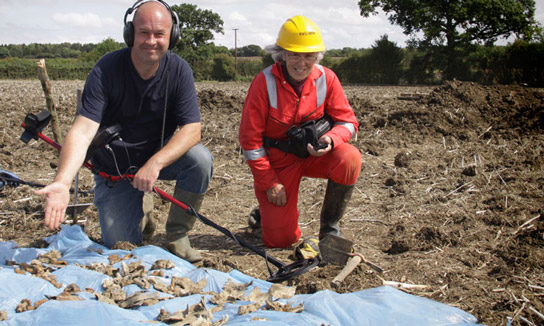The first organised licensed archaeological excavation of this type in the UK took place on Saturday August 13th 2011. This particular He 177 had been intercepted on the night of 18th 19th April 1944 whilst engaged in Operation Steinbock. It was shot down by a 410 “Cougar” Squadron Mosquito N.FX111 Coded MM-456. crewed by Flight Lieutenant Stanley Byron Huppert and Pilot Officer John. S. Christie. Sadly within 7 years of despatching this massive Heinkel from Britain`s wartime skies these men would be dead, killed whilst flying Mosquito’s, both men coming down in the sea. The Heinkel took some 110 rounds of 20mm ammunition to destroy after which it crashed into a grass field near Little Walden in Essex.
Amazingly John Christies relatives in New Zealand traced me through doing some genealogical research and were able to provide me with copies of pages from Christies Log Book and most importantly crash site photographs of this particular Heinkel He 177 photographs which I believe are now unique. This triggered me to re-investigate the crash site to see what remained. One of the UK`s leading aviation archaeologists Gareth Jones initially gained permission from Mr Duke the landowner for an investigation.
Recently I was asked to field test the X-TERRA 305 metal detector and it was this detector that pin pointed exactly where the Heinkel had come to earth 67 years before. Truly a case of today’s sophisticated technology hunting for the then sophisticated technology of some seven decades previous.
After several metal detection surveys the impact point was firmly established and the tasks connected with organising of the excavation could begin. On the day of the “dig” we conducted an “X” configuration of trenches over the site and were delighted to find, Plexiglas, engine casing, gear cogs, cable trim wheels, corroded airframe, exploded 13mm cannon shell cases and small electrical components.
The maximum depth was only some 1.5 feet which was expected as the wartime photographs confirmed the impact was largely a surface burn out. However given the conditions of other Heinkel He 177 crash sites in UK relating to missing aircrew, bomb-loads and general aerial disintegration it would seem that this is not only the first but will probably be the only ever archaeological examination of this type of aircraft to be conducted in Britain.

The artefacts recovered are in process of being cleaned and conserved and will form another unique part of preserved history, just one of many thousands of similar historical rescues that Minelab products have been at the active forefront of achieving.
Crash details:
Aircraft Heinkel He 177 A-3
Date Tuesday18th- Wednesday19th April 1944 (at night)
Operation Steinbock also known as “The Baby Blitz”
Time 1.03a.m
Unit 2/KG100
Code 6N+AK
Werke Nummer 332379
Crash Location Near edge of field at Butlers Farm near Ashdon / Little Walden in Essex
Crew
Pilot Feldwebel Heinz. Reis - bailed out and captured
Observer Feldwebel. Weinand. Hock - bailed out and captured
Bordfunker Unteroffizier Johannes. Wehr - bailed out and captured
Bordschutze (Tail) Obergefreiter. Werner. Heidorn - bailed out and captured
Unteroffizier Georg. Speyerer - Died
Obergefreiter Fritz. Kopf - Died
Julian Evan-Hart




















Comments
It's definitely exciting to be a part of any effort to recover history. Great job! We were discussing situations just like this at the Minelab conference in Chicago last month, and I think it's awesome to see Minelab products aiding in the recovery of historic items such as the Heinkel.
I hope you get a chance to get back out there and continue assisting in their recovery project!
Shack